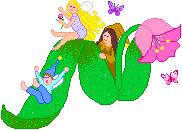Herbal Adventures with Susun S Weed
The Asteraceae ("aster" means "star") family
by Susun S. Weed
read other Herbal Adventures part 1, part 2 , part 3 , part 4
as seen printed in www.sagewoman.com
Herbal medicine is people's medicine, earth medicine, wild medicine, weed medicine. Weeds are amazing powerhouses of nourishment, medicine, magic, and beauty. They are easy to grow and simple to use.  But beginners, and seasoned herbal users as well, can sometimes feel lost: so many herbs, so many plants, so many weeds to get to know. How can one even begin to feel confident?
But beginners, and seasoned herbal users as well, can sometimes feel lost: so many herbs, so many plants, so many weeds to get to know. How can one even begin to feel confident?
One of the best ways to "get" herbal medicine is to learn a little botany. Plants are grouped into botanical families, and plants in the same family often have very similar properties. In previous columns, we've looked at the malva (Malvaceae), the rose (Rosaceae) and the buckwheat (Polygonaceae) families. That's about 5000 plants we've become familiar with. But that's only a few, compared to the family we're about to meet: the Asteraceae (Aster-a-cee-a).
With 20,000 members, the Asteraceae ("aster" means "star") family is one of the largest and most diverse of all plant families. From fossil records, it appears that this family developed quite recently (only millions of years ago) and this may explain its size. The Asteraceae family contains some of the most helpful, and well known, of all herbs: arnica, burdock, boneset, calendula, chamomile, chicory, mug/cronewort, coltsfoot, dandelion, echinacea, elecampane, feverfew, gravel root, grindelia, liferoot, milk thistle, tansy, yarrow, valerian, wormwood, and wild lettuce.
It offers us delicious foods: sunflower seeds, lettuces, true artichokes, sun chokes (also known as jerusalem artichokes), escarole, and endive. And, it is one of the landscaper's favorite families, for many Asteraceae--such as chrysanthemums, dahlias, bachelor's buttons, daisies, cosmos, coneflowers, goldenrods, sunflowers, zinnias, and, of course, asters--bloom for months with colorful hardy flowers, and many are perennial, too.
Plants become members of a family when their flower structures are the same. But dandelion and burdock and sunflowers don't seem to look alike. How can they all be in the same family? The flowers of the Asteraceae are much smaller than you think, that's how. The flower you see is not the flower that a botanist sees. Where you see one dandelion bloom, the botanist sees hundreds of small flowers arranged to look like one flower.
The older name for this family tells the tale more clearly: Compositae. Each bloom is composed of hundreds of tiny flowers. With a hand lens, you can look closely at an Asteraceae blossom and see the many tiny flowers crowded together that make up the larger "flower."
Look at a sunflower; even a picture will do. You can clearly see the many little yellow flowers that make up the disk, or center, of the sunflower. Eventually, each one of those disk flowers, which are fertile, will become a seed. Now look at what you thought were the sunflower petals. Each yellow petal is actually an entire flower, called a ray flower. The ray flowers of the sunflower are sterile, thus produce no seeds.
To see a fertile ray flower, look at a dandelion in bloom. Each of those yellow strands that makes up the dandelion "mop" is an individual ray flower; and each one makes a seed. (There are no disk flowers on the dandelion.)
Some Asteraceae have disk flowers, but no ray flowers, like goldenrod or sagebrush or some forms of chamomile. So there are really three flower patterns in the Asteraceae family: ray and disk flowers together (echinacea, daisy, black-eyed susans); only ray flowers (dandelion, lettuce, artichoke); and only disk flowers (wormwood, ragweed).
In general, Asteraceae are considered edible and safely medicinal, but they often contain very active ingredients along with their exceptional supplies of nutrients. Many Asteraceae contain active alkaloids that are medicinal; but that means they can be harmful, too. (It's the alkaloids in dandelion, chicory, escarole, endive, and old lettuce that make them taste so bitter.) Two helpful medicinal Asteraceae--boneset (Eupatorium perfoliatum) and queen of the meadow (E. purpurea)--have a dreadful sister (E. rugosum) known as "white snake root."
This sister contains an alkaloid that, eaten by cows and excreted in their milk, builds up in people who drink the milk and causes their eventual death. Abraham Lincoln's mother died as a result of it, in fact. Even common garden lettuce contains alkaloids that are comparable to opium alkaloids; and the sap of wild lettuces has long been used, as opiates are to this day, to ease severe pain.
Since roots and seeds are usually richer in alkaloids than leaves and flowers, it is safest to experiment first with the flowers of unfamiliar Asteraceae. I read that native women valued Senecio aureus so much they called it "liferoot." Great; it grows here. I'll dig some root. Then I learned that some Senecios species are considered livestock poisoners. Hmmm, maybe I shouldn't.
Finally, my archeologist neighbor told me that Senecio flower pollen was found around the oldest known human grave. Ah ha! Of course! Tincture the flower. Voila! I've seen a dose of 5-8 drops of liferoot flower tincture, taken daily from ovulation to menstruation for at least three cycles, restore menstrual happiness to the most pained of women.
Asteraceae pollens in both fresh and dried flowers can cause breathing problems and allergic reactions in susceptible, or sensitized, individuals.  Ragweed (Ambrosia artemisifolia) is in this family, remember. There have been several close calls with children reacting badly to chamomile, and two deaths from echinacea. (It is thought that they sensitized themselves by daily use of echinacea capsules, and went into shock when they took a larger dose. There have been no problems with large doses of echinacea root tincture; but I would not take it daily.)
Ragweed (Ambrosia artemisifolia) is in this family, remember. There have been several close calls with children reacting badly to chamomile, and two deaths from echinacea. (It is thought that they sensitized themselves by daily use of echinacea capsules, and went into shock when they took a larger dose. There have been no problems with large doses of echinacea root tincture; but I would not take it daily.)
What Asteraceae grow wild around you? Which ones do you or your friends cultivate? Whether you use their roots, their leaves, or their flowers for medicine, magic, food, or beauty, the star-studded Asteraceae family is twinkling at you.
Medicinal Asteraceae Stars
Arnica (Arnica montana) flowers relieve muscle pain.
Burdock (Arctium lappa) root nourishes deep health.
Boneset (Eupatorium perfoliatum) herb banishes flu.
Calendula (Calendula officinalis) flowers salve wounds.
Chamomile (Anthemis nobilis or Matricaria chamomilla) soothes baby.
Chicory (Cichorium intybus) root strengthens the liver.
Coltsfoot (Tussilago farfara) flowers ease coughs.
Dandelion (Taraxacum officinalis) herb improves liver function.
Echinacea (Echinacea augustifolia) root counters bacterial infections.
Elecampane (Inula helenium) root is a favorite lung healer.
Feverfew (Chrysanthemum parthenium) prevents migraines.
Grindelia (Grindelia robusta) herb in flower opens breathing, stops itching.
Liferoot (Senecio aureus) flower tincture counters severe menstrual pain.
Milk thistle (Silybum marianum) seed tincture prevents liver distress.
Mug/cronewort (Artemisia vulgaris) herb is an old woman's friend.
Queen of the meadow/gravel root (Eupatorium purpurea) helps the kidneys.
Tansy (Tanacetum vulgare) flowers repel insects.
Yarrow (Achillea millefolium) flowers heal wounds, prevent colds.
Valerian (Valeriana officinalis) root brings sleep.
Wormwood (Artemisia absinthemum) herb prevents parasites.
Wild lettuce (Lactucca species) sap eases severe pain.

Dear Susun,
When I was younger I took a lot of recreational drugs, and sometimes I drink more alcohol than I should. I also drink at least one cup of coffee a day, sometimes two or three. And last year, when I was really sick, I took antibiotics. Well, obviously, my liver is clogged with all kinds of toxins. How do I get rid of them? What herbs do you suggest I use to cleanse my liver?
Thank you. PT from MI
Dear PT,
Wait! Don't cleanse your liver. It won't help you; and it can harm you.
Let's take a look at how the liver operates. As blood moves through it--and all of your circulating blood passes through your liver hourly--it is not filtered, but restored. Toxins do not build up in there; the liver removes them. Oil-soluble vitamins and glucose are stored in the liver, but chemicals, drugs, and toxins are not.
Drugs, metabolic by-products, alcohol, hormones, cholesterol, vitamins, minerals, enzymes, bacteria, viral particles, and all the chemical detritus of living in the blood are judged by the liver: some are allowed to stay, others dismantled for recycling, and some are removed.
Water-soluble chemicals, such as ammonia, are excreted when you pee. To get a sense of how quickly water-soluble chemicals are removed from your body, eat some asparagus, which contains the mildly-poisonous water-soluble chemical asparagine. Notice how quickly you have to "go," and the smell of the asparagine in your urine. Oil-soluble chemicals may be excreted in breast milk, ejaculations, ovulations, and tears, but most are locked up in fat cells, where they can do little harm. (Neither water- nor fat-soluble chemicals can be excreted by sweating. Minerals can, however, and that threatens the health of your bones.)
Yes, you can damage your liver with alcohol and drugs. But the liver is amazingly regenerative. Every cell in a healthy liver is replaced every forty days. So, instead of cleansing--which can increase the damage--I prefer to make my liver strong and healthy by nourishing it.
The liver-nourishing herbs I love include dandelion, chicory, yellow dock, and milk thistle. Milk thistle is best used before the fact, not after; it is highly protective of the liver. When milk thistle seed tincture (a dose is a dropperful) is taken before chemotherapy, heavy drinking, or exposure to concentrations of chemicals, the liver can more easily recycle and remove what is not needed.
For daily nourishment however, there's nothing better than dandelion. If you live too far to the north or south for dandelion to grow, try chicory or yellow dock instead. They are hardier weeds, and great substitutes. All parts of dandelion, chicory, and yellow dock are medicinal and restorative to the liver. Roots are most commonly used--usually tinctured, although vinegars work just as well. A dose of 10-25 drops, or a tablespoon of the vinegar in water or on a salad, taken in the morning and before will bring fast results. (Regular use of apple cider vinegar has been found to drastically reduce the incidence of adult-onset diabetes.)
Additionally, you'll make your liver very happy if you:
Eat regularly. Skipping meals and fasting reduces liver efficiency quickly.
Eat cooked food. Raw foods contain bacterial, viral, and enzymatic substances that stress, and may even cause an infection in, the liver.
Eat enough fat; but avoid oils pressed from seeds, which increase inflammation. As dietary fat decreases, so does the liver's ability to metabolize glucose, fatty acids, and cholesterol.
Get angry. The liver is the storehouse of unexpressed rage.
Avoid essential oils; they impair liver function. Choose unflavored toothpastes and mouthwashes, and unscented soaps, skin lotions, deodorants, antiperspirants, and candles.
Avoid herbs that are rich in alkaloids or other natural chemicals, including most herbs used in "cleansing" such as golden seal, senna, cascara sagrada, celandine, chaparral, lobelia, rhubarb root, cayenne, and poke root.
Instead of coffee, start your day with nourishing herbal infusion. You'll be surprised at the energy and stamina you'll have.
 Good health and green blessings. Susun
Good health and green blessings. Susun






